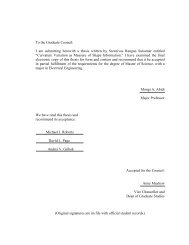Fusion of Visual and Thermal Face Recognition Techniques: A ...
Fusion of Visual and Thermal Face Recognition Techniques: A ...
Fusion of Visual and Thermal Face Recognition Techniques: A ...
You also want an ePaper? Increase the reach of your titles
YUMPU automatically turns print PDFs into web optimized ePapers that Google loves.
various features in feature spaces. Methods <strong>of</strong> feature fusion, including several features<br />
such as edges, corners, lines, texture parameters, are computed <strong>and</strong> combined in a fused<br />
feature map that may then be used for segmentation or detection. Features obtained after<br />
dimension reduction such as PCA, LDA, ICA, LFA <strong>and</strong> other feature extraction methods<br />
also can be used for a fused feature map. Decision <strong>Fusion</strong> (high level), combines<br />
decisions coming from several experts. Methods <strong>of</strong> decision fusion include majority<br />
voting, ranked list combination, AND fusion, OR fusion. A detailed analysis <strong>of</strong> fusion<br />
methods can be reviewed at [39][41].<br />
Numerous attempts have been made in the field <strong>of</strong> face recognition to fuse different<br />
modalities. But relatively less publications are available in this area. Ben-Yacoub. et al<br />
fused face <strong>and</strong> speech data enhances personal identification [42]. Gutta. et al [43] fused<br />
using multiple neural networks classifiers to classify gender, ethnic origin, <strong>and</strong> pose <strong>of</strong><br />
human faces. They improved the overall face recognition system. Fang. et al [44] tried to<br />
fuse local features <strong>and</strong> global features using SVM (Support Vector Machine). Chang, et<br />
al [45] proved that multimodal recognition using both the face <strong>and</strong> the ear significantly<br />
improved the overall performance over a single modality. Accuracy using the face, ear<br />
<strong>and</strong> fused recognition was 70.5%, 71.6% <strong>and</strong> 90.9% respectively. Wilter. et al [46] <strong>and</strong><br />
authors from Equinox [34][35][36] fused visual <strong>and</strong> thermal images using the fusion <strong>of</strong><br />
experts algorithm <strong>and</strong> showed better performance over single modalities. Challenging<br />
problems in visual face recognition can be solved with the use <strong>of</strong> thermal images to<br />
improve overall performance.<br />
Figure 1 shows a general framework for the comparison <strong>of</strong> face recognition<br />
performance with five different cases; visual (Vi), thermal (Th), data fusion (Df), two<br />
13
















